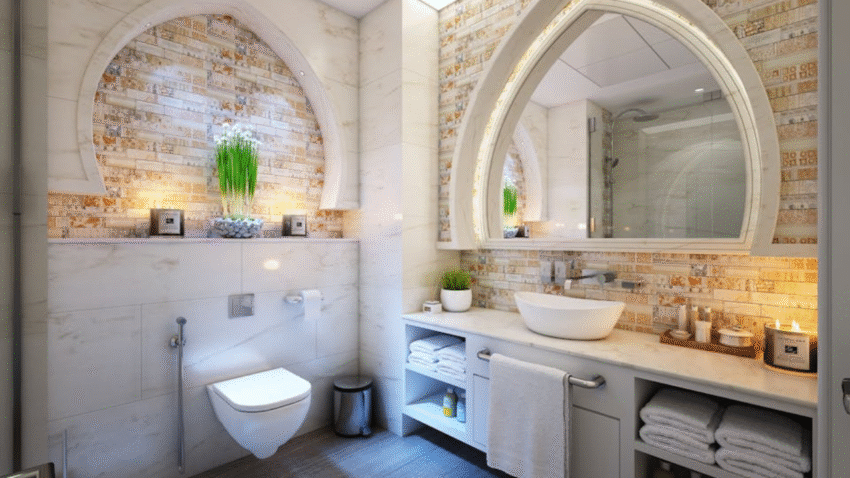Introduction
Thinking of giving your bathroom a fresh new look? This guide will show you how to paint bathroom walls like a pro—even if you’re a DIY beginner. Bathrooms are high-moisture spaces, so painting them requires more prep and care than other rooms. Tired of peeling paint or streaky finishes? Let’s fix that with pro-level results and a flawless finish.
Why Painting Bathroom Walls Matters
A new coat of paint in your bathroom does more than just look good—it also protects your walls from moisture, mold, and mildew. Bathrooms are filled with humidity, which can cause standard paint to bubble, peel, or stain. Using the right materials and techniques not only boosts your bathroom’s visual appeal but also ensures long-term durability. Whether you’re covering up outdated colors or refreshing faded walls, proper painting prevents damage, improves air quality, and increases your home’s value.
Step-by-Step Guide to Painting Bathroom Walls Like a Pro
1. Choose the Right Paint
Select a paint specifically designed for high-moisture areas. The best types include:
- Satin or semi-gloss finish: These resist moisture and are easier to clean
- Mold- and mildew-resistant formulas: Great for bathrooms with poor ventilation
- Acrylic-latex paint: Durable and fast-drying for DIY use
Stick with light to medium shades to reflect light and make the room feel bigger.
Tip: Always buy a little extra paint for touch-ups later. Bathrooms are small, but wall textures and multiple coats can use more than expected.
2. Gather Your Tools and Materials
Here’s what you’ll need:
- High-quality paint roller and tray
- Angled paintbrush for edges and corners
- Painter’s tape
- Drop cloths or old towels
- Spackle and putty knife
- Sandpaper (fine grit)
- Cleaning solution (mild soap or vinegar water)
- Primer (if painting over dark colors or stains)
Optional: Use a small step ladder for hard-to-reach areas safely.
3. Prep the Bathroom
Prepping is key for a professional result. First:
- Remove all items from the bathroom, including rugs, wall art, shelves, and towels
- Clean the walls with mild soap or a vinegar solution to remove dirt, dust, and residue
- Scrape off any peeling or flaking paint
- Fill nail holes or dents with spackle, let dry, then sand smooth
Tip: Turn on the exhaust fan or open a window to reduce humidity while you work.
4. Protect Surfaces
Use painter’s tape to cover:
- Trim, baseboards, and ceiling edges
- Around the mirror, toilet tank, and vanity
- Fixtures like light switches and towel bars (if you don’t remove them)
Lay drop cloths on the floor and over the toilet or sink. Paint splatters happen—even to the pros.
5. Prime the Walls (If Needed)
If you’re painting over a dark color, stains, or a glossy finish, apply a primer coat. Primer helps paint stick better and ensures even coverage.
Use a roller for large areas and an angled brush for edges. Let the primer dry fully (typically 2–4 hours) before moving on.
Pro tip: Use a moisture-resistant primer for the best protection in humid spaces.
6. Cut in the Edges
“Cutting in” means painting around the edges of walls and fixtures before rolling. Use an angled brush and paint 2–3 inches out from corners, ceilings, and trim. This avoids roller overlap and creates a clean border.
Tip: Work in small sections and keep a wet edge to avoid visible seams when rolling.
7. Roll the Paint on Evenly
Pour your paint into a tray and load your roller evenly. Start painting in a “W” or “M” pattern, then fill in the gaps. Apply steady, even pressure to avoid streaks or splatter.
Work from top to bottom and allow the first coat to dry fully (about 4 hours) before applying a second coat. Two coats are usually needed for full coverage and durability.
Important: Don’t press too hard with the roller—it can leave visible marks once the paint dries.
8. Remove Tape Before Paint Fully Dries
Once the final coat is dry to the touch, carefully remove the painter’s tape at a 45-degree angle. Doing this while the paint is still slightly soft prevents peeling.
Tip: Use a utility knife to lightly score along the tape edge if paint has already dried, which ensures a clean line.
Common Mistakes to Avoid
Mistake 1: Using Flat or Matte Paint
These finishes absorb moisture and stain easily.
Solution: Use satin or semi-gloss for easy cleaning and moisture resistance.
Mistake 2: Skipping the Prep Work
Dirty or uneven walls cause poor adhesion.
Solution: Always clean, patch, and sand before you paint.
Mistake 3: Painting Over Mildew
Mildew can grow back under paint.
Solution: Clean walls with a vinegar-water solution or anti-mold spray before painting.
Mistake 4: Rushing Between Coats
Applying a second coat too soon can cause smudging or peeling.
Solution: Allow full drying time between coats—typically 4 hours or as directed on the can.
Mistake 5: Not Ventilating the Room
Paint fumes can linger in small bathrooms.
Solution: Use fans, open windows, and keep the door open while painting and drying.
Extra Tips & Bathroom Hacks
- Use a foam roller for a smoother finish: It reduces texture lines and gives walls a clean, pro-level look.
- Keep a damp rag handy: Wipe up drips immediately before they dry.
- Don’t forget the ceiling: If your bathroom ceiling looks dingy, use mold-resistant ceiling paint for a full refresh.
Want to upgrade your bathroom even more? Check out our guide on how to repaint your bathroom cabinets or vanity.
Conclusion
Painting your bathroom walls like a pro takes a little extra care—but the payoff is worth it. By choosing the right paint, prepping your surfaces properly, and using clean, steady techniques, you’ll get a smooth, durable finish that can withstand the humid environment of any bathroom. Take your time and enjoy the transformation!
🖌️ Bookmark this guide so you’re always ready to refresh your space with confidence!
